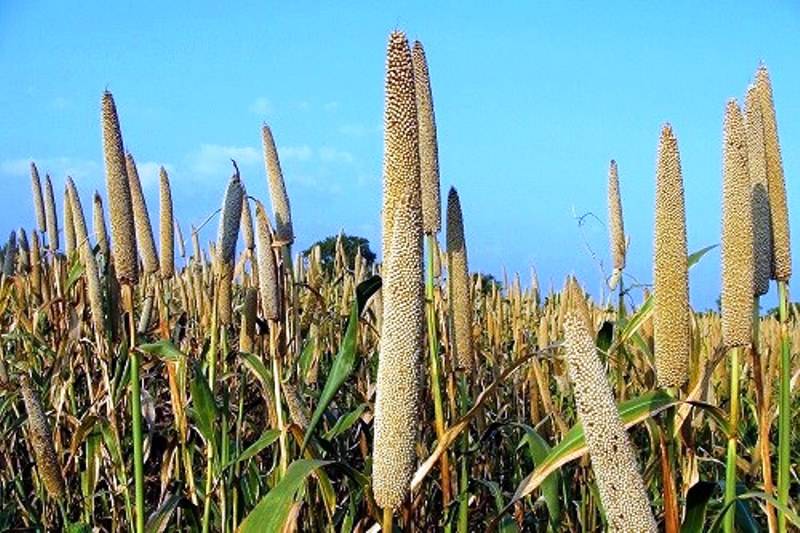
“The rice eater is weightless like a bird, the one who eats jowar is strong like a wolf; one who eats ragi remains ‘nirogi’(illness-free) throughout his life”- an old Kannada saying
Millet is a dietary staple and the main source of protein in most of the developing world. Globally, millet is the sixth most cultivated grain after corn, rice, wheat, barley and sorghum. It is very much suited to drought conditions and has great natural biodiversity. It can be cultivated in a variety of locations. They are one of the oldest foods known to humans and possibly the first cereal grain to be used for domestic purpose.
Millets are grown on marginal lands by some of the poorest and marginalised communities – the Dalits, the Adivasis and the women in the dry land and hilly region. The millet symbolizes the food and knowledge sovereignty of Indian farmers and ensures a life of dignity and self-reliance for them. Most of the millet fields are inherently bio-diverse and no real farmer grows millets as a monocrop. They grow millets in combination with a host of pulses, legumes, vegetables and oilseeds.
There are many factors that make millets more sustainable as crops. According to ICRISAT, one rice plant requires nearly 2.5 times the amount of water required by a single millet plant of most varieties. That is why millets are primarily grown in arid regions of Asia, Africa and Latin America.
Millets can also withstand higher temperatures. Crops like rice and wheat can’t tolerate temperature more than 38-degree centigrade, while millets can tolerate a temperature of more than 460 degrees C. They can grow in saline soil. They can thus be grown as an important solution for farmers grappling with climate changes sea level rise which leads to increase in soil salinity, heatwaves, droughts, floods etc. Due to this peculiar nature, they are termed as the “miracle grains” or the “crops of the future”. Millets are cultivated as dual-purpose crops (food and fodder). Millets help in reducing the atmospheric CO2 as this contribute to mitigating the climate change.
India is the largest producer of many kinds of millets, which are often referred as coarse cereals. Apart from India, Nigeria, China, Mali, Burkina Faso, Sudan, Ethiopia, Chad, Senegal are the leading millet producers in the world.
History of Millets
Millets are the some of the oldest of the cultivated crops and a group of highly valuable small-seeded grasses, widely grown around the world as cereal crops or grains for human food and as fodder. The Chinese believe that millet was brought from the heavens by Houji or “Lord Millet”. Millet was one of the five sacred grains in ancient China. By around 5000 BC, people in North-Central China were depending on millet as a staple food and by about 3000 BC millet was a staple food all over northern China. Millets have been important food staple in human history, particularly in Asia and Africa for the last 10,000 years. In India, millets have been mentioned in some of the oldest Yajurveda texts, identifying foxtail millet (priyangava), Barny and millet (aanara) and black finger millet (shyaamaka), this indicating that millet consumption was very common, pre dating to the Indian Bronze Age (4,500BC).
Millets made a perfect bridge between nomadic life and settled agriculture because they have a very short grooming season- just 45 days, compared to 100 crores more for rice and need very little attention.
Millet has a long history of being fermented or distilled into alcohol. In Africa, malted millet is brewed into a beer known as Kaffir beer or banta beer. In Nepal and Tibet, raksi is traditional liquor distilled from millet. In the US, Koval Distillery in Chicago has distilled a whiskey from millet.
Nature’s Nutraceuticals
Millets are called ‘sridhanya’ meaning rich grains refreshing to their nutritional value. They can fill the nutritional gaps when one’s diet is predominantly non-vegetarian. In terms of nutritional value, millets can supersede rice and wheat. Millets are an extremely good source of fibre and protein when compared with white rice. They are rich in iron, copper, manganese, calcium, phosphorous, magnesium and B vitamins. They also contain antioxidants, flavonoids, certain amino acids and tryptophan. Millets in our diet ensure glycerine control which in turn is effective against diabetes. They can lower the risk of Type 2 diabetes. Millets are heart friendly and good in atherosclerosis. They do a lot of good to people suffering from hypothyroidism and women suffering from the polycystic ovarian disease. Millets also improve muscle and nerve health. A small quantity of millets gives satiety and thus prevents an increase in weight. This is a blessing for those who suffer from obesity.
Major millets
Pearl millet/bajra/kambu
Pearl Millet is the most widely grown type of millet and India is the largest producer of pearl millet. It is a rich source of Phosphorus, which plays an important role in the structure of body cells. Consumption of pearl millets helps in minimizing the risk of type 2 diabetics.
Finger millet /ragi
Ragi is very popular in southern India. it is rich in calcium and protein and also have a good amount of iron and other minerals. Ragi tops in antioxidant activity and has a good number of essential amino acids.
Foxtail millet/thennai
Foxtail millet is high in iron content. They can control blood sugar and cholesterol levels and increase HDL cholesterol.
Kodo millet/varagu
Kodo millets contain high amounts and polyphenols, an antioxidant compound. They have high fibre, low fat and are good for diabetes.
Little millet/chama
Little millet is smaller than other millets and high in iron content, high in fibre and has high antioxidant activities. It helps in diabetes and diseases related to stomach
Barnyard Millet/Kuthirarahi.
Barnyard millet is high in fibre content, phosphorous and calcium. it has low glycerine index and this helps in type 2 diabetes, control and prevents cardiovascular disease.
Sorghum/Jowar/Cholam
One of the ancient cereal grains with high nutritional value, high levels of unsaturated fats, protein fibre and minerals like phosphorous, potassium, calcium and iron. Sorghum helps to improve metabolism.
Health benefits of millets
The health benefits of millets can be detailed as follows:
Good for heart health
Millets being a rich source of magnesium serves as an important mineral for reducing blood pressure and the risk of heart attacks or strokes, particularly in the case of atherosclerosis. Since it is also a great source of potassium; it keeps blood pressure low by acting as a vasodilator. The plant lignans found in millet can be converted to animal lignans by the microflora in our digestive system which provides protection against certain chronic diseases like cancer.
Controls cholesterol level
The high fibre level in millets helps in cholesterol-lowering and making it ideal. This eliminates dangerous “bad cholesterol” (LDC) from the system and also promotes the effects of good cholesterol (HDC).
Prevents diabetes
The significant levels of magnesium found in millets help in reducing the chance of Type 2 diabetes. Since, it increases the efficiency of insulin and glucose receptors in the body, thereby preventing the diseases.
Digestive health
Being fibre-rich millets can help to keep up the health of the gastrointestinal system and eliminate problems like constipation, excess gas, bloating and cramping. By regulating the digestive process nutrient retention can also be improved reducing the chances of serious gastrointestinal conditions like gastric ulcers etc. Moreover, regular digestion and elimination of waste help to optimize kidney, liver and immune system health.
Prevents Cancer
Recent research has revealed fibre to be one of the best and easiest ways to prevent the onset of cancer especially breast cancer in women. In fact, women can reduce their chances of breast cancer by more than 50% by eating more than 30 grams of fibre every day.
Detoxifies the Body
Antioxidants found in millets neutralize free radicals and also clean up other toxins from the body. Quercetin, curcumin, ellagic acid and various other beneficial catechins help to rid system of any foreign agents and toxins by promoting proper execution and neutralizing enzymatic activity in the organs.
Some important points about Millets
Due to its high resistance to harsh conditions, millets are sustainable to the environment, to the farmer growing it and provide cheap and high nutrient options for all.
Nearly 40 percent of the food produced in India is wasted every year. Millets don’t get destroyed easily and some of the millets are good for consumption even after 10-12 years of growing, thus providing food security and keeping a check as food wastage.
Millets is really an umbrella term for around 20 species of cereal grass from the Poaceae family.
The hulls of millet seed can be used to make filling for pillows.
At room temperature, millet can be stored in a sealed, dry container for years or so.
In a broad sense millets are pest-free crops.
Millets can grow on the poorest of soils.
Millets are well known for their short growing season. They can develop from planted seeds to mature, ready to harvest plants in as little as 65 days.









